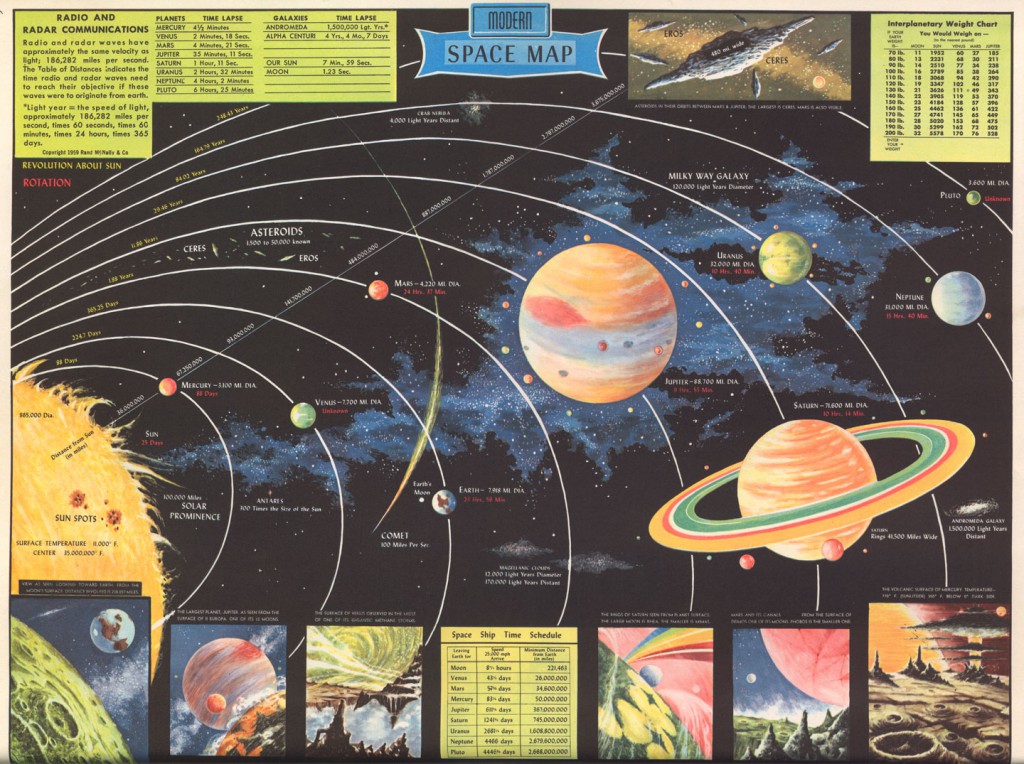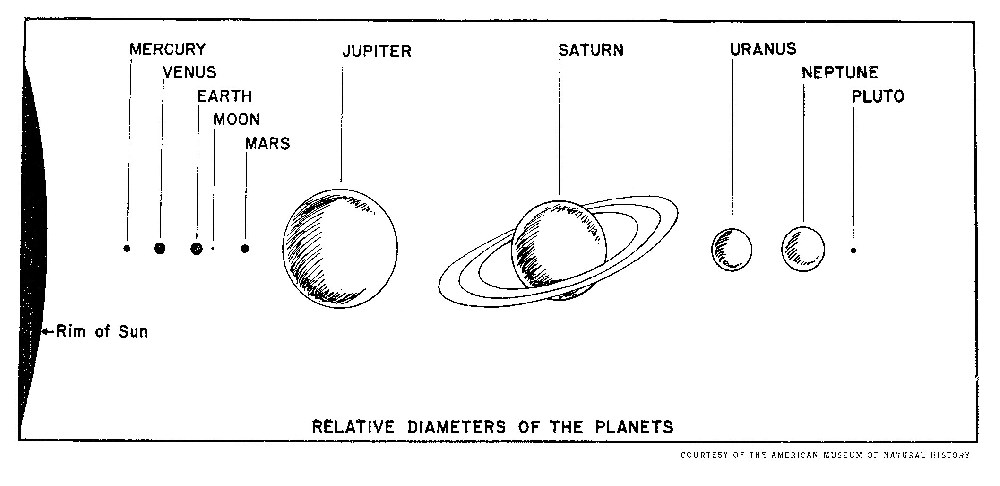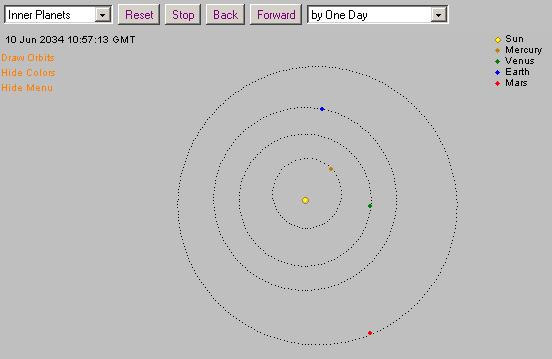My Ancient and Unfortunately Unshakable Visualization of the Solar System
1. Concerning My Ongoing, Erroneous, but Somehow Charming Conception That the Solar System Really Does Look Like This 1959 Space Map
 This childhood map of the solar system has remained locked in my mind since I was seven. Whenever I think of any planet, whenever I see a news report on a planetary probe, whenever I read about a planet in a novel, or write about it in one of my own, I see that planet and all its siblings floating to the right of that way-too-small sun exactly as depicted here.
This childhood map of the solar system has remained locked in my mind since I was seven. Whenever I think of any planet, whenever I see a news report on a planetary probe, whenever I read about a planet in a novel, or write about it in one of my own, I see that planet and all its siblings floating to the right of that way-too-small sun exactly as depicted here.
This map dominated my childhood Draft One of The Martian Marauders in 1965-66. When Jack pilots the Typhoon I to Mars, he simply heads a few inches north. When his ship is destroyed over Mercury, Jack and brother Joe can easily drift in a space lifeboat to Earth in a couple days, and when the two are subsequently captured on Earth, they’re taken to a Venusian prison which is of course just a little bit northwest.
The Space Map influenced the solar system disasters which I rendered so eloquently in that 8th grade version of The Martian Marauders:
Since the year 2020 the solar system seemed to be breaking down. In 2020 many famous asteroids were flung into the sun. In 2021, the planet Pluto was hurled from our solar system, never to return. Scientists and astronomers traced it to a fiery end when it was swept into a sun near our solar system in 2028. In 2023 Neptune, somehow becoming radioactive, blew up, hurling pieces at Uranus, which a few months later hurled itself into the sun, and in doing so, just missed Earth. Perhaps the most tragic and symbolic disaster occurred in 2031 when the most beautiful and graceful planet, Saturn, collided with the strongest and mightiest planet, Jupiter, in a blinding flash of light occurring about midnight on July 15, 2031.
In 2033, the earth became unfit for man, who was forced to journey to and live on Mars.
From examining the Modern Space Map, anyone would conclude that Jupiter and Saturn really had no choice but to collide, and that if Uranus, irrationally attacked by Neptune, did plunge into the sun, it definitely would just miss Earth by a hair. Evacuating the earth’s population to Mars wasn’t a terribly inconvenient journey, either.
When I morphed the childhood story into a modern novel, I had much explaining to do about such eighth grade catastrophes. But I came up with a lot of improvements, most importantly the idea that the telepathic Martians, in experimenting with Amplified Thought so they could move planets around for their nefarious purposes, were clumsily destroying everything they touched!
The modern Martian Marauders still couldn’t stretch credulity to have Jupiter and Saturn collide, so I had the Martians blow them up. But the fact that Jupiter and Saturn will be on opposite sides of the sun on July 15, 2031 means that the Martian feat of blasting them simultaneously is all the more impressive.
2. The Fifties Colliers Encyclopedia Provided a Grasp of Relative Sizes
But I was also influenced as a child by a slightly more rigorous view of the solar system, tempering the above fallacy to a certain degree. This was a drawing in the Solar System entry in the family’s late 1950’s Collier’s Encyclopedia. I consulted the Colliers drawing so frequently that to this day I recall it was on page fifteen of volume eighteen.
 So at least I had a decent idea of the relative sizes of the planets from the beginning of my amateurish astronomical interest. I knew Jupiter was the biggest planet the same way I knew Tyrannosaurus Rex was the biggest meat-eating dinosaur. During a move in 2002 I had to discard the mildewed encyclopedia, kept for sentimental reasons but foolishly stored in the garage. However, I cut out and saved Volume Eighteen’s section on the solar system, which is why you are fortunate to have this 1950’s schematic. But I never noticed until now how crude that drawing really is. Look at the shading on Jupiter and Saturn.
So at least I had a decent idea of the relative sizes of the planets from the beginning of my amateurish astronomical interest. I knew Jupiter was the biggest planet the same way I knew Tyrannosaurus Rex was the biggest meat-eating dinosaur. During a move in 2002 I had to discard the mildewed encyclopedia, kept for sentimental reasons but foolishly stored in the garage. However, I cut out and saved Volume Eighteen’s section on the solar system, which is why you are fortunate to have this 1950’s schematic. But I never noticed until now how crude that drawing really is. Look at the shading on Jupiter and Saturn.
I do recall being impressed by my first childhood look at the rim of the sun. What ungraspable immensity!
Still, relative distances and positions were always skewed by the Modern Space Map and by this schematic, which does show the planets nicely bunched together.
3. What it Really Looks Like, Sort of
For the modern Jack Commer novels, I used a web site that seems to have been around since the nineties, the Solar System Clock of the WWW, to calculate rough distances and positions.
Though I’ve been quite grateful to the site for straightening out a lot of my plot lines, its Java requirement may balk some browsers. Here’s an example of one of its simple images, showing the inner planets on 6/10/34 during the action for The Martian Marauders:
 Of course the Typhoon I top ends at 49.8 million miles per hour, so nobody has to figure out complicated orbital trajectories to save fuel. You just point the ship at whatever object you want to visit!
Of course the Typhoon I top ends at 49.8 million miles per hour, so nobody has to figure out complicated orbital trajectories to save fuel. You just point the ship at whatever object you want to visit!
4. Raw Empty Space
Finally, to get a glimpse of the raw empty space in our neighborhood, try this site I ran across recently:
If the Moon Were Only 1 Pixel – A Tediously Accurate Map of the Solar System
You can scroll on your own by clicking the right arrow, or if you click the “c” in the lower right corner you can let the site move you along at the speed of light (relative to the screen’s distances, that is), a movement which comes across as quite disturbingly slow …
And curiously, the moon being one pixel is somewhat like the moon’s dot in the Collier’s schematic!
You will probably get extremely sick of doing this by the time you get to Jupiter. I actually missed Saturn entirely my first time because I was just holding down the right arrow and forgot where I was, moving as I was much faster than the speed of light. And consider that this empty space has to be magnified enormously, as we’re looking at just one line of orbits sweeping 360 degrees.
This model, like many others I’ve run across, also makes use of the convention of running the solar system from Sun on the left to Pluto on the right–in other words, just like the Modern Space Map.
The solar system is our first priority. We have a credible chance of exploring it and making good use of it long before we understand how to leave it entirely. But it’s so vast and empty that, well, it’s damn scary is what is it. And it turns our daily logic inside out.
In science fiction we visualize our ship entering an unknown solar system, where we can see a bright sun in the center, but somehow we also see all these gas giants and planets whirling in their orbits. In fact we’d have to hunt for these planets. We wouldn’t see them at first, or we’d just catch some dots of light indistinguishable from stars. And nobody would draw nice white orbit lines for us anyway.
Copyright 2015 by Michael D. Smith
And a postscript: some other Solar System visualization sites I found during writing this post:
https://janus.astro.umd.edu/SolarSystems/
http://www.solarsystemscope.com/
http://www.brightonastronomy.com/
http://www.astronoo.com/en/articles/positions-of-the-planets.html
And a word I learned: orrery; plural orreries: a mechanical model of the solar system, or of just the sun, earth, and moon, used to represent their relative positions and motions.
And a completely irrelevant warning: I also have an extremely illogical visualization of the twelve months of the calendar which I’ve never been able to draw and which seems impossible to describe in words. It would look something like an M. C. Escher print. But I can keep time with it and I can’t imagine ever changing it.

Pingback:Draft and Final Covers: The Martian Marauders – Sortmind Blog
Pingback:Draft and Final Covers: The Martian Marauders – Sortmind Blog – Michael D. Smith